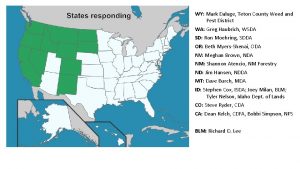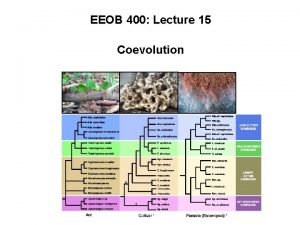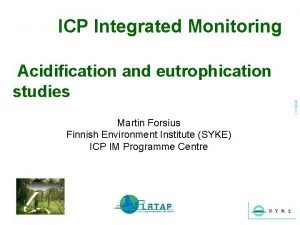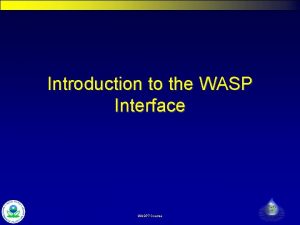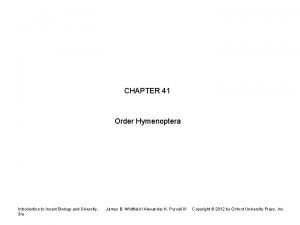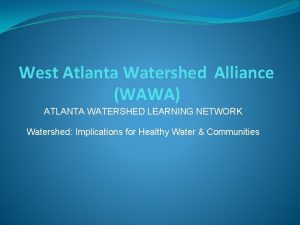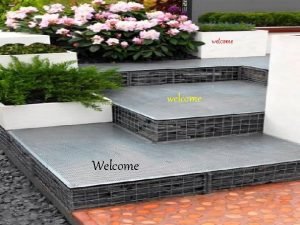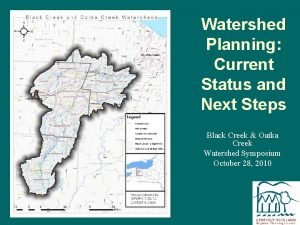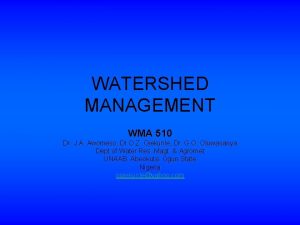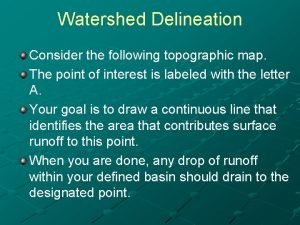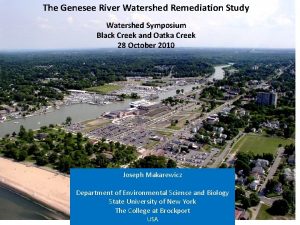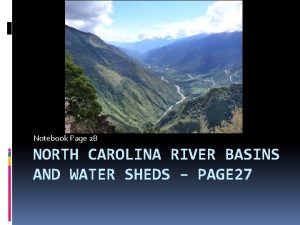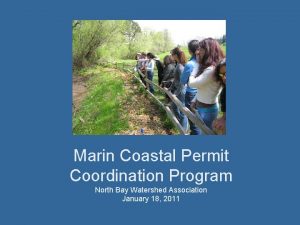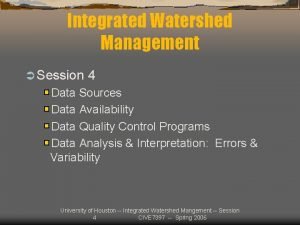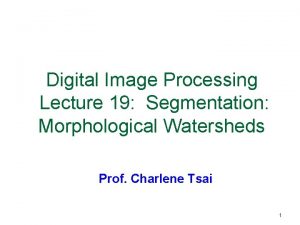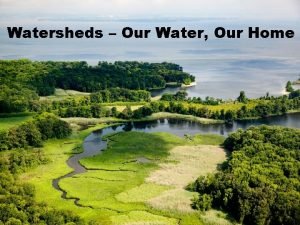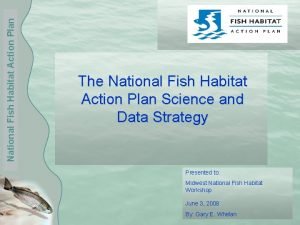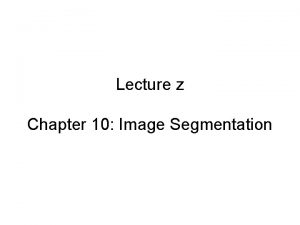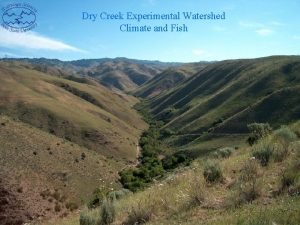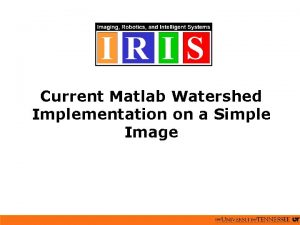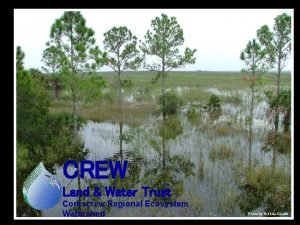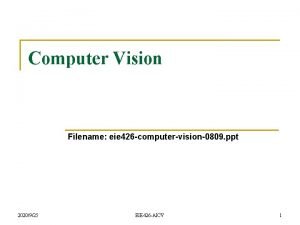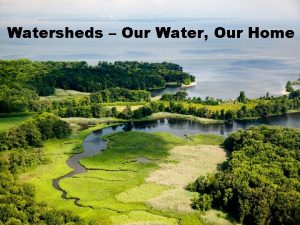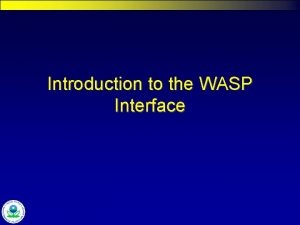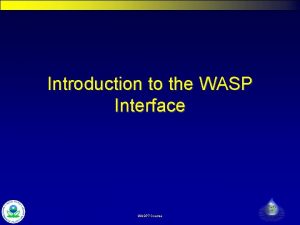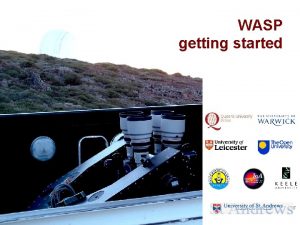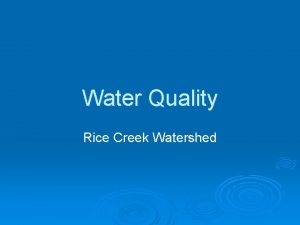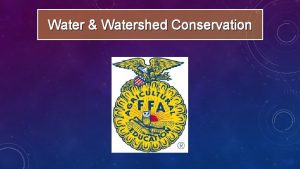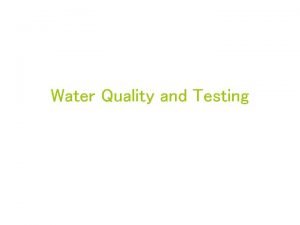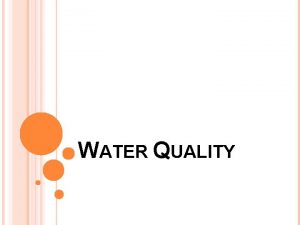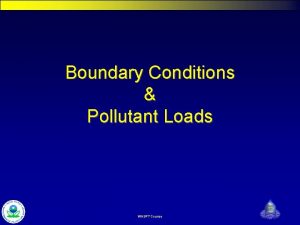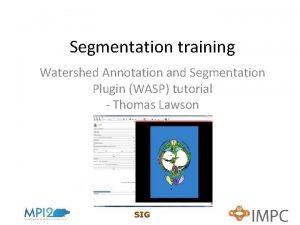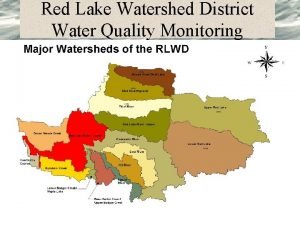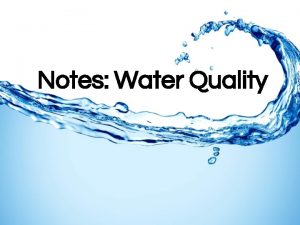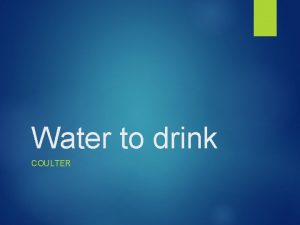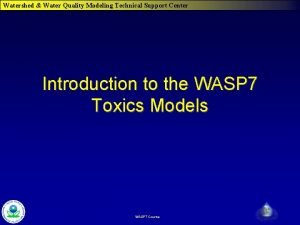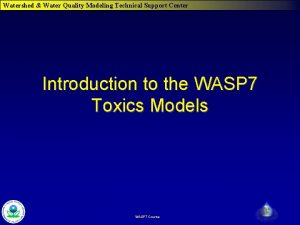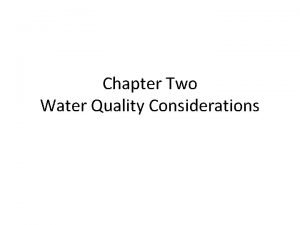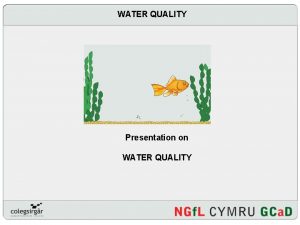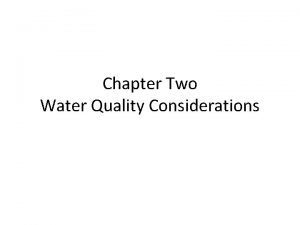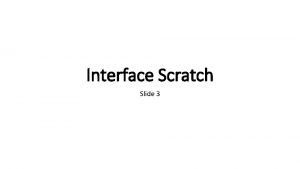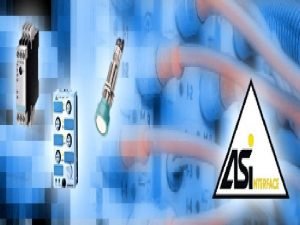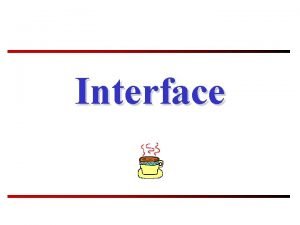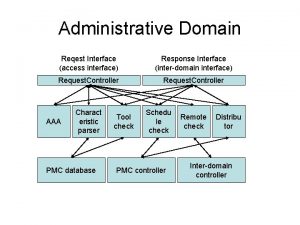Introduction to the WASP Interface Watershed Water Quality



































- Slides: 35

Introduction to the WASP Interface

Watershed & Water Quality Modeling Technical Support Center Introduction to WASP Interface Input File Run Control Simulation Input Data Specification Import Output Network Control

Watershed & Water Quality Modeling Technical Support Center Create New WASP Input File – 1. Creates a blank WASP Input File (wif). – 2. Save button will be activated. Press save and specify name and directory for the new input file (e. g. , CSTR Test. wif).

Watershed & Water Quality Modeling Technical Support Center Open Existing WASP Input File – Browse and select an existing Wasp Input File – WASP provides a listing of *. wif in the current directory.

Watershed & Water Quality Modeling Technical Support Center WASP Input Data Categories 1 2 3 4 5 6 7 8 9 10 11 12 1. 2. 3. 4. 5. 6. Simulation Control Time Step Print Interval Segment Properties System Properties Parameter Switches 7. Constants 8. Loadings 9. Kinetic Time Functions 10. Dispersive Exchanges 11. Advective Flows 12. Boundary Concentrations

Watershed & Water Quality Modeling Technical Support Center Simulation Control • Description and Comments • Model Type • Simulation Start Date & Time • Non Point Source Linkage • Hydrodynamic Option and Linkage • Restart Option • Bed Volume Option • Time Step Option • Negative Solution Option • Press “i. OK” and save

Watershed & Water Quality Modeling Technical Support Center Time Step – Sets duration of simulation – Specifies calculational time steps, in days – Steps: • Press “+ Insert” twice • Highlight and edit “Date” and “Time” in row 2 • Highlight and edit time step “Value” in rows 1 and 2 • Note: if desired, additional time steps can be specified by pressing “+ Insert” and editing the additional rows • Press “i. OK” and save

Watershed & Water Quality Modeling Technical Support Center Print Interval – Specifies output print intervals, in days – Steps: • Highlight and edit print interval “Value” in rows 1 and 2 • Note: if desired, additional print intervals can be specified by + pressing “ Insert” and editing the additional rows • Press “i. OK” and save

Watershed & Water Quality Modeling Technical Support Center Segment Properties - Geometry • Steps to specify simple network geometry: • Press “+ Insert” to create segment rows • Highlight and edit Description, Volume, and Depth Multiplier for rows • Select Segment Type • Press “i. OK” and save

Watershed & Water Quality Modeling Technical Support Center Segment Properties - Parameters • Steps to specify parameters: • Press “Parameters” to enter screen • Highlight and edit parameter values for rows • Press “i. OK” and save

Watershed & Water Quality Modeling Technical Support Center Segment Properties – Initial Concentrations • Steps to specify initial concentrations: • Press “Initial Concentrations” to enter screen • Highlight and edit concentration values in segment rows • Press “i. OK” and save

Watershed & Water Quality Modeling Technical Support Center Segment Properties – Fraction Dissolved • Steps to specify dissolved fractions: • Press “Fraction Dissolved” to enter screen • Highlight and set solids dissolved fractions to 0 • Toxicant dissolved fractions do not need to be reset from the default of 1; they are recalculated by the model throughout the simulation • Press “i. OK” and save

Watershed & Water Quality Modeling Technical Support Center Systems • Steps to specify system properties: • Use pick list to simulate or bypass state variables and reset particulate transport fields for sand organic solids • Highlight and set solids particle densities (g/m. L) and maximum concentrations; toxicant values do not need to be reset from default • Edit boundary and loading scale factors as desired (default is 1. 0) • Press “i. OK” and save

Watershed & Water Quality Modeling Technical Support Center Parameters – Switch • Steps to enable parameters: • Point and click on Used field to select or de-select parameters (parameter values are specified under Segments, but will not be used unless selected here) • Edit parameter scale factors as desired (default is 1. 0) • Press “i. OK” and save

Watershed & Water Quality Modeling Technical Support Center Constants Steps to specify constants: • Use pick list to select Constant Group • Point and click on Used field to select or deselect constants • Highlight and set values for constants • Press “i. OK” and save

Watershed & Water Quality Modeling Technical Support Center Direct Loads Steps to specify loads: • Highlight and right click on variable • Select Add/Remove Loads • In new dialogue box, point and click on boxes to select segments receiving loads (not shown in diagram) • Press “i. OK” at bottom of dialogue box • Continue adding loading segments to varables

Watershed & Water Quality Modeling Technical Support Center Direct Loads, continued Steps to specify loads: Note: variables with concentrations in mg/L have loading values in kg/day • Click on + by variable to unpack loading segments • Highlight segment • In bottom window, fill in loading values (kg/day) for beginning and ending times • As needed, add time rows by pressing “+ Insert” and edit Date, Time, and Value • Continue entering loading data for all variables and segments • Press “i. OK” and save

Watershed & Water Quality Modeling Technical Support Center Kinetic Time Functions Steps to specify time functions: • Point and click on Used field to select or de-select time functions • Highlight Time Function • In bottom window, fill in time function values for beginning and ending times • As needed, add time rows by pressing “+ Insert” and edit Date, Time, and Value • Continue selecting time functions and entering data • Press “i. OK” and save

Watershed & Water Quality Modeling Technical Support Center Dispersive Exchanges Bulk dispersive exchange flows among model segments

Watershed & Water Quality Modeling Technical Support Center Dispersive Exchanges Step 1. set exchange function • Point and click on Used field to select or de-select exchange fields • Highlight Pore Water exchange field • Click in upper right window, then press “+ Insert” • Beginning and ending dates will appear in the lower right window • Exchange function name can be edited

Watershed & Water Quality Modeling Technical Support Center Dispersive Exchanges - continued Step 2. specify exchange pairs • Click in lower left window, then press “+ Insert” for each exchange pathway • For each row in the exchange pathway, highlight and select From and To segments, and specify exchange area (m 2) and mixing length (m) • Press “i. OK” and save

Watershed & Water Quality Modeling Technical Support Center Dispersive Exchanges continued. Step 3. define time function • In the lower right window, specify dispersion coefficients for the beginning and ending dates • Flows are in m 2/sec; to use different units (here cm 2/sec), specify appropriate Conversion Factor in upper left window (e. g. , m 2/cm 2) • For additional entries in the flow time function, press “+ Insert” and edit Date, Time, and Value • Press “i. OK” and save

Watershed & Water Quality Modeling Technical Support Center Advective Flows Step 1. set flow function • Point and click on Used field to select or deselect flow fields • Highlight Surface Water flow field • Click in upper right window, then press “+ Insert” • Beginning and ending dates will appear in the lower right window • Flow function name can be edited

Watershed & Water Quality Modeling Technical Support Center Advective Flows - continued Step 2. define flow path • Click in lower left window, then press “+ Insert” for each entry in the flow pathway • For each row in the flow pathway, highlight and select From and To segments, and specify flow fraction value (default = 1. 0) • Press “i. OK” and save

Watershed & Water Quality Modeling Technical Support Center Advective Flows - continued Step 3. define time function • In the lower right window, specify flow values for the beginning and ending dates • Flows are in m 3/sec; to use different units (here m 3/day), specify appropriate Conversion Factor in upper left window (e. g. , day/sec) • For additional entries in the flow time function, press “+ Insert” and edit Date, Time, and Value • Press “i. OK” and save

Watershed & Water Quality Modeling Technical Support Center Boundaries Steps to specify boundary concentrations (BCs): • Click on “+” by each variable to unpack boundary segments • Highlight segment • In bottom window, fill in concentration values (mg/L) for beginning and ending times • As needed, add time rows by pressing “+ Insert” and edit Date, Time, and Value • Continue entering BC data for all variables and boundary segments • Press “i. OK” and save

Watershed & Water Quality Modeling Technical Support Center WASP Output Variable Selection • Point and click on Output field to select or de-select variables for WASP postprocessor. • Point and click on CSV field to select or de-select variables for external CSV files. A separate csv file will be created for each variable.

Watershed & Water Quality Modeling Technical Support Center Execute Model Simulation -1 • Press WASP execute button to begin simulation.

Watershed & Water Quality Modeling Technical Support Center Execute Model Simulation - 2 • A table of calculated concentrations will be displayed throughout the simulation. • Status and error messages will be displayed. • Progress through the simulation is summarized along the bottom bar. A control slide can be used to speed up, slow down, or freeze the simulation. • The simulation can be aborted by pressing the stop button (circled above).

Watershed & Water Quality Modeling Technical Support Center Execute Model Simulation - 3 • When the result file is closed, simulated results can be viewed by launching the WASP postprocessor, or by opening the variable csv files that were created.

Watershed & Water Quality Modeling Technical Support Center WASP Output csv file Time, days Output variable by segment in columns

Watershed & Water Quality Modeling Technical Support Center WASP Postprocessor Select Output File • Press File Open for list of WASP output files (*. BMD) • Highlight and select output file • Press Open

Watershed & Water Quality Modeling Technical Support Center WASP Postprocessor Select Variable and Segment to Plot 1. Press X-Y Plot button 2. Press Add Curve button 3. Highlight and select variable and segment and press OK button 4. Repeat 2 and 3 for additional variables & segments on graph 5. Press OK button to view graph

Watershed & Water Quality Modeling Technical Support Center WASP Postprocessor Example Graph • Press Add Curve button to create more graphs

Watershed & Water Quality Modeling Technical Support Center WASP Postprocessor Example Table • Press Tabular Results button to display table of results
 Water and water and water water
Water and water and water water Cockroach control teton county
Cockroach control teton county The wasp factory analysis
The wasp factory analysis Parasitism
Parasitism Why is “the spider and the wasp” an expository essay?
Why is “the spider and the wasp” an expository essay? Fig wasp
Fig wasp Syke wasp exterminator
Syke wasp exterminator Examples of stabilizing selection
Examples of stabilizing selection Wasp 7
Wasp 7 Braconid wasp and tomato hornworm symbiotic relationship
Braconid wasp and tomato hornworm symbiotic relationship Biology
Biology Interface in interface java
Interface in interface java Areas of the screen that behave as if they were independent
Areas of the screen that behave as if they were independent Office interface vs industrial interface
Office interface vs industrial interface Interface------------ an interface *
Interface------------ an interface * Wawa in atlanta
Wawa in atlanta Gabion structure watershed
Gabion structure watershed Components of a watershed
Components of a watershed Watershed management meaning
Watershed management meaning Topographic map watershed delineation
Topographic map watershed delineation Genesee river watershed
Genesee river watershed Difference between watershed and river basin
Difference between watershed and river basin North bay watershed association
North bay watershed association Integrated watershed management
Integrated watershed management Watershed morphology
Watershed morphology Brain watershed areas
Brain watershed areas Watershed poster ideas
Watershed poster ideas Local watershed definition
Local watershed definition Watershed segmentation
Watershed segmentation History of development communication ppt
History of development communication ppt Green river (duwamish river tributary)
Green river (duwamish river tributary) Dry creek experimental watershed
Dry creek experimental watershed Pseudocolor matlab
Pseudocolor matlab Wawa menu
Wawa menu Watershed segmentation
Watershed segmentation Watershed poster ideas
Watershed poster ideas

